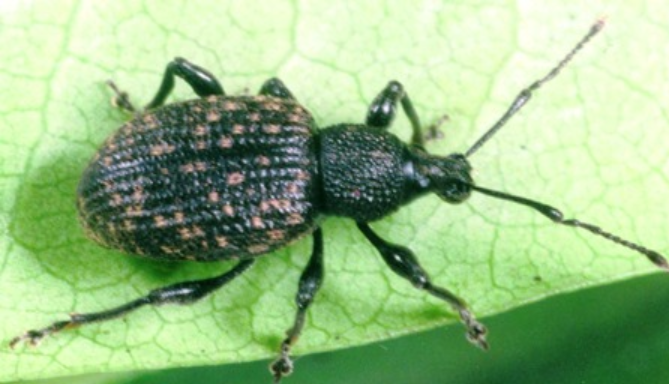I’ve just spent hours picking over compost from a (once-beautiful) planter full of polyanthus, removing tens of vine weevil grubs – each one a menace. Oh why, oh why didn’t I use Nemasys Vine Weevil Killer, the nematode mix that’s like Nemaslug …but for vine weevils???
The plump, creamy coloured grubs are about 10mm long, creamy coloured and often curled in a‘C’ shape, until disturbed. They have a distinct gingery coloured head but no legs. They feed below ground, especially in pots and containers full of proprietary compost, eating roots and tunneling into tubers (eg begonias). Their activities cause plants to wilt and die back and are often kill the plants. My polyanthus had stopped growing, looked miserable and were definitely on the way out.
The adults are a matt-black often with tiny gingery speckles on their wing cases and about 10cm long, mostly active after dusk and often causing damage in a less insidious way as they only take notches from around the leaf edges.
The adult vine weevils are all female and each one lays most of her eggs during spring and summer and these then hatch into the grubs which feed intensely, mainly between early autumn and mid-spring. Each one can lay several hundred eggs. The eggs are tiny (less than 1mm in diameter) and so almost impossible to spot on soil or compost. If you find brownish often moisture-filed spheres which are several mm in diameter in the compost, these are controlled release fertiliser granules! The grubs pupate in the compost or soil before hatching out into a fully-formed adult, at this time of year you are likely to find grubs but very soon they will have eaten their fill of your plants and you will also find pupating ones.
So what can you do?
First, try to prevent the problem : If you’re lucky enough not to have vine weevils yet or indeed if you simply don’t want to make an existing problem worse, always inspect new plants carefully before introducing them to your garden. Always use fresh compost in containers as compost used for repeated plantings often acts as a breeding ground for the weevil and numbers soon build up!
Despite the fact that vine weevils have wing-cases, they are fused and so adult vine weevils cannot fly and rely purely on walking and crawling to move themselves from place to place.
The vine weevils’ feet are also hugely grippy and allow them to grip to almost completely smooth surfaces, making scaling the side of an un-glazed pot simple. They make this pest an extremely capable climber and vine weevils are commonly found attacking plants on balconies and in widow boxes.This may sound crazy but it works : stand pots on ‘pot feet’ or similar which are stood within a tray of water. Vine weevils cannot swim and so, provided the plant and compost are not infested and there is no other way in, the plants should remain protected by the ‘moat’. Top dress compost with gravel or grit to create an unsuitable and unappealing place for the female weevil to lay her eggs.
If you have , like me, already found the grubs you need to act fast : Drench the moist compost with the biological control nematodes from Nemasys (the stuff I said is just like Nemaslug, but for use on vine weevils, not slugs!), applications made when there are large numbers of grubs in evidence are most effective. This control is extremely effective on plants growing in compost but less so on heavier soils. Soil needs to be above 5C and kept moist. It works a treat in containers and you should ideally treat all containers as if you have it in some, chances are others are also infested. For more information on the biocontrol or to purchase it visit www.pippagreenwood.com/products/protect-your-crops. It is brilliant stuff and works really well when applied to compost containing the grubs, best times to apply are spring (but this year they are already there and perfect for treating!!) and late summer when again there tend to be lots of grubs at the right stage for killing with Nemasys nematodes. We can get it to you very speedily!
Just one final word of warning : Adult vine weevils do most of their feeding at night but, whatever the time of day, if disturbed, will ‘play dead’ , become motionlessoften for several minutes as they attempt to fool predators (and yes, gardeners too!) into thinking they are dead and so not to be eaten or squashed!
By getting them sorted ASAP you can save a lot of damage later in the year so get yourself some Nemasys nematodes (which, by the way are totally safe for use in gardens frequented by kids (and other humans!), pets or wildlife.

